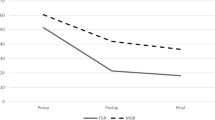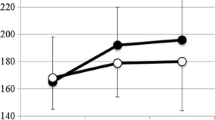Abstract
Purpose
Preliminary results of magnetically controlled growing rods (MCGR) are encouraging. However, only short case series of MCGR for the treatment of early onset scoliosis (EOS) have been reported. Our aim was to evaluate its effectiveness and complications.
Methods
We report a 30-case retrospective, consecutive, multicenter series of MCGR. Effectiveness was judged upon: deformity correction and difficulties to achieve desired distraction. Secondary endpoints included complications and revision surgeries.
Results
Median age at surgery was 9.1 years (5–13). Mean follow-up was 18.4 months (12–33.9). Mean Cobb angle was 66° preoperatively and 44° at latest follow-up. MCGR has avoided an average of 2.03 scheduled surgical procedures per patient compared to traditional growing rod (GR). The intended total length gain was 40.1 mm per patient (5–140) and the total measured length gain was 21.9 mm (45.5% discrepancy). There were 24 complications: 7 proximal pull-outs of the hooks, 3 rod breakages, 6 failures of the lengthening of which 4 complete blockages and 2 complete blockages followed by backtracking, 1 proximal junctional kyphosis, 1 wound dehiscence, 1 superficial infection, 1 deep infection requiring implant removal, 1 pulmonary embolism, 1 pulmonary insufficiency, 1 secondary lumbar scoliosis, and 1 painful outpatient distraction. Eight patients had a gradual loss of effectiveness of distractions. There were 13 revision surgeries in 9 patients.
Conclusions
MCGR provides satisfactory deformity correction and avoids repeated surgical procedures for lengthening. However, it has substantial complication rate. Although less frequent than in GR, the law of diminishing returns also applies to MCGR.











Similar content being viewed by others
References
Harrington PR (2002) Treatment of scoliosis: correction and internal fixation by spine instrumentation. J Bone Joint Surg Am 84-A(2):316
Karol LA, Johnston C, Mladenov K, Schochet P, Walters P, Browne RH (2008) Pulmonary function following early thoracic fusion in non-neuromuscular scoliosis. J Bone Joint Surg Am 90(6):1272–1281
Dannawi Z, Altaf F, Harshavardhana NS, El Sebaie H, Noordeen H (2013) Early results of a remotely-operated magnetic growth rod in early-onset scoliosis. Bone Jt J 95-B(1):75–80
Yang JS, McElroy MJ, Akbarnia BA, Salari P, Oliveira D, Thompson GH et al (2010) Growing rods for spinal deformity: characterizing consensus and variation in current use. J Pediatr Orthop 30(3):264–270
Thompson GH, Akbarnia BA, Campbell RM (2007) Growing rod techniques in early-onset scoliosis. J Pediatr Orthop 27(3):354–361
Akbarnia BA, Breakwell LM, Marks DS, McCarthy RE, Thompson AG, Canale SK et al (2008) Dual growing rod technique followed for three to eleven years until final fusion: the effect of frequency of lengthening. Spine 33(9):984–990
Sankar WN, Acevedo DC, Skaggs DL (2010) Comparison of complications among growing spinal implants. Spine 35(23):2091–2096
Akbarnia BA, Cheung K, Noordeen H, Elsebaie H, Yazici M, Dannawi Z et al (2013) Next generation of growth-sparing techniques: preliminary clinical results of a magnetically controlled growing rod in 14 patients with early-onset scoliosis. Spine 38(8):665–670
Hickey BA, Towriss C, Baxter G, Yasso S, James S, Jones A et al (2014) Early experience of MAGEC magnetic growing rods in the treatment of early onset scoliosis. Eur Spine J Off Publ Eur Spine Soc Eur Spinal Deform Soc Eur Sect Cerv Spine Res Soc 23(Suppl 1):S61–S65
Cheung KM-C, Cheung JP-Y, Samartzis D, Mak K-C, Wong Y-W, Cheung W-Y et al (2012) Magnetically controlled growing rods for severe spinal curvature in young children: a prospective case series. Lancet 379(9830):1967–1974
Stokes OM, O’Donovan EJ, Samartzis D, Bow CH, Luk KDK, Cheung KMC (2014) Reducing radiation exposure in early-onset scoliosis surgery patients: novel use of ultrasonography to measure lengthening in magnetically-controlled growing rods. Spine J Off J North Am Spine Soc 14(10):2397–2404
Pérez Cervera T, Lirola Criado JF, Farrington Rueda DM (2015) Ultrasound control of magnet growing rod distraction in early onset scoliosis. Rev Espanola Cirugia Ortop Traumatol 60(5):325–329. doi:10.1016/j.recot.2015.01.001
Dimeglio A, Canavese F (2012) The growing spine: how spinal deformities influence normal spine and thoracic cage growth. Eur Spine J Off Publ Eur Spine Soc Eur Spinal Deform Soc Eur Sect Cerv Spine Res Soc 21(1):64–70
Harrington PR (1963) Scoliosis in the growing spine. Pediatr Clin N Am 10:225–245
Moe JH, Kharrat K, Winter RB, Cummine JL (1984) Harrington instrumentation without fusion plus external orthotic support for the treatment of difficult curvature problems in young children. Clin Orthop 185:35–45
Bess S, Akbarnia BA, Thompson GH, Sponseller PD, Shah SA, El Sebaie H et al (2010) Complications of growing-rod treatment for early-onset scoliosis: analysis of one hundred and forty patients. J Bone Joint Surg Am 92(15):2533–2543
Akbarnia BA, Marks DS, Boachie-Adjei O, Thompson AG, Asher MA (2005) Dual growing rod technique for the treatment of progressive early-onset scoliosis: a multicenter study. Spine 30(17 Suppl):S46–S57
Farooq N, Garrido E, Altaf F, Dartnell J, Shah SA, Tucker SK et al (2010) Minimizing complications with single submuscular growing rods: a review of technique and results on 88 patients with minimum two-year follow-up. Spine 35(25):2252–2258
Suliman S, Mkabile SG, Fincham DS, Ahmed R, Stein DJ, Seedat S (2009) Cumulative effect of multiple trauma on symptoms of posttraumatic stress disorder, anxiety, and depression in adolescents. Compr Psychiatry 50(2):121–127
Backeljauw B, Holland SK, Altaye M, Loepke AW (2015) Cognition and brain structure following early childhood surgery with anesthesia. Pediatrics 136(1):e1–e12
Caldas JCS, Pais-Ribeiro JL, Carneiro SR (2004) General anesthesia, surgery and hospitalization in children and their effects upon cognitive, academic, emotional and sociobehavioral development—a review. Paediatr Anaesth 14(11):910–915
Charroin C, Abelin-Genevois K, Cunin V, Berthiller J, Constant H, Kohler R et al (2014) Direct costs associated with the management of progressive early onset scoliosis: estimations based on gold standard technique or with magnetically controlled growing rods. Orthop Traumatol Surg Res Otsr 100(5):469–474
Rolton D, Richards J, Nnadi C (2015) Magnetic controlled growth rods versus conventional growing rod systems in the treatment of early onset scoliosis: a cost comparison. Eur Spine J 24(7):1457–1461. doi:10.1007/s00586-014-3699-7
Rolton D, Thakar C, Wilson-MacDonald J, Nnadi C (2016) Radiological and clinical assessment of the distraction achieved with remotely expandable growing rods in early onset scoliosis. Eur Spine J 25(10):3371–3376. doi:10.1007/s00586-015-4223-4
Keskinen H, Helenius I, Nnadi C, Cheung K, Ferguson J, Mundis G et al (2016) Preliminary comparison of primary and conversion surgery with magnetically controlled growing rods in children with early onset scoliosis. Eur Spine J Off Publ Eur Spine Soc Eur Spinal Deform Soc Eur Sect Cerv Spine Res Soc 25(10):3294–3300
Choi E, Yazsay B, Mundis G, Hosseini P, Pawelek J, Alanay A et al (2016) Implant complications after magnetically controlled growing rods for early onset scoliosis: a multicenter retrospective review. J Pediatr Orthop. doi:10.1097/BPO.0000000000000803
Ridderbusch K, Rupprecht M, Kunkel P, Hagemann C, Stücker R (2016) Preliminary results of magnetically controlled growing rods for early onset scoliosis. J Pediatr Orthop. doi:10.1097/BPO.0000000000000752
Blakemore LC, Scoles PV, Poe-Kochert C, Thompson GH (2001) Submuscular Isola rod with or without limited apical fusion in the management of severe spinal deformities in young children: preliminary report. Spine. 26(18):2044–2048
Thompson GH, Akbarnia BA, Kostial P, Poe-Kochert C, Armstrong DG, Roh J et al (2005) Comparison of single and dual growing rod techniques followed through definitive surgery: a preliminary study. Spine 30(18):2039–2044
Yang JS, Sponseller PD, Thompson GH, Akbarnia BA, Emans JB, Yazici M et al (2011) Growing rod fractures: risk factors and opportunities for prevention. Spine 36(20):1639–1644
Sankar WN, Skaggs DL, Yazici M, Johnston CE, Shah SA, Javidan P et al (2011) Lengthening of dual growing rods and the law of diminishing returns. Spine 36(10):806–809
Noordeen HM, Shah SA, Elsebaie HB, Garrido E, Farooq N, Al-Mukhtar M et al (2011) In vivo distraction force and length measurements of growing rods: which factors influence the ability to lengthen? Spine 36(26):2299–2303
Author information
Authors and Affiliations
Corresponding author
Ethics declarations
Conflict of interest
There is no conflict of interest or funding or grants in this study.
Ethical approval
Ethics Committee gave its agreement for this work.
Informed consent
Informed consent was obtained from all individual participants included in the study.
Rights and permissions
About this article
Cite this article
Lebon, J., Batailler, C., Wargny, M. et al. Magnetically controlled growing rod in early onset scoliosis: a 30-case multicenter study. Eur Spine J 26, 1567–1576 (2017). https://doi.org/10.1007/s00586-016-4929-y
Received:
Revised:
Accepted:
Published:
Issue Date:
DOI: https://doi.org/10.1007/s00586-016-4929-y




